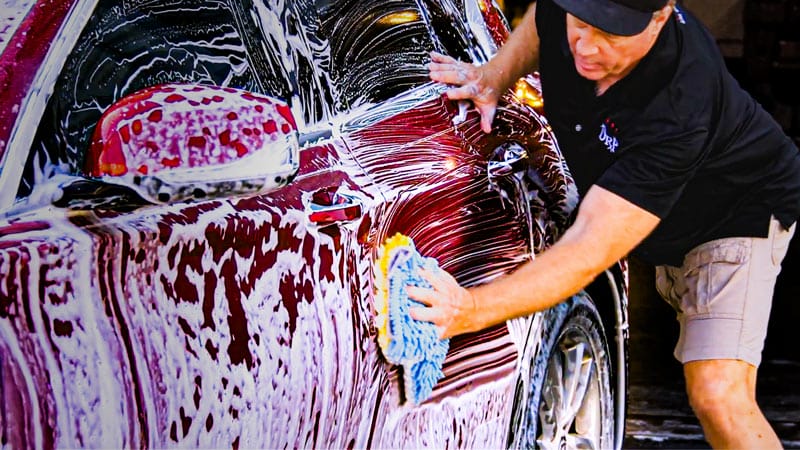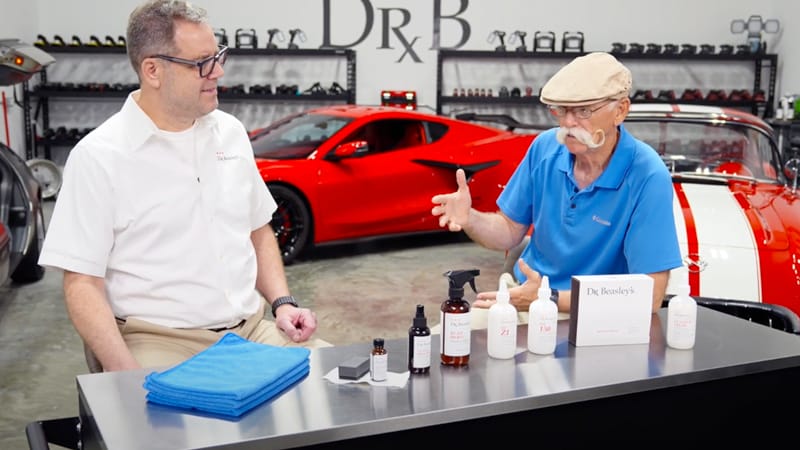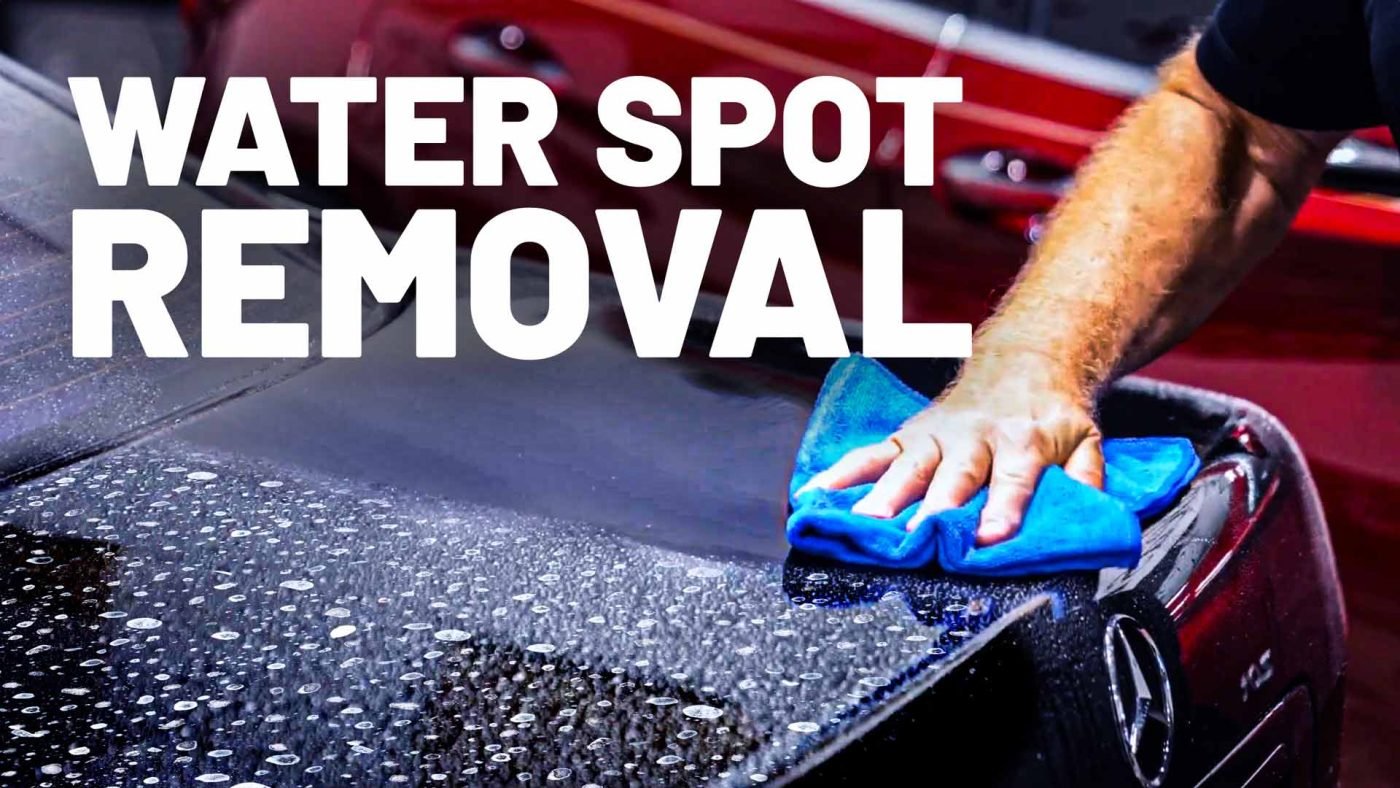Transcript
Today we’re going to talk about water spots. I would say that, besides swirls and scratches, the other most common annoying type of defect in your paint that people absolutely hate, and it makes your car look ugly, are water spots.
Now, water spots come from different types of chemicals in the water and different sources. For example, one of the most common places to get water spots is if your car gets hit by a sprinkler.
Okay, so sprinklers use either city water or well water. And nowadays, this water, even though it’s filtered, it’s still contaminated. It has a lot of different chemicals and minerals in it. And when these things dry on your paint, the water evaporates, it leaves whatever was dissolved in that water on the paint surface. And a lot of times those are what we call hard water spots or hard water mineral spots.
Rainwater, Pollution, and Etching vs. Deposits
So, the other way you get water spots is actually from the rain. And the problem with the rain is now there’s just so much pollution in the air. Plus, any dirt or dust or air pollution that lands on your car—when the water hits it, it becomes a corrosive mixture and it leaves a spot.
And then there’s a number of different types of spots. But the two most common are mineral deposits, which are sitting on the surface, and imprint rings or crater etchings, where the paint has actually been etched or modified by the corrosive elements in the water. And a lot of times the only way to remove those is by machine polishing.
Now, the mineral deposits that are sitting on top of the paint—those can oftentimes be removed using a water spot remover.
Don’t Rely on Vinegar
Now, I’m going to go over a number of different tips and techniques and products, but you don’t have to remember all this. In the description below, there’s actually a link to a PDF file for a checklist that I use when inspecting and removing water spots off cars.
Okay, before we get started, one of the things I just want to talk about is vinegar. Okay, a lot of times you see people talking about using vinegar to remove water spots. And the thing about vinegar is vinegar is a weak form of acetic acid. It has a low pH. Okay. The most common form of mineral deposit is calcium hydroxide and it has a high pH.
So, if—and that’s a big if—if vinegar would work, it’s pretty much only going to work on calcium hydroxide mineral deposits. And you’ll still probably have to either use a dedicated water spot remover because it’s just not going to be strong enough. But I just wanted to kind of dispel the whole myth about vinegar. Does it work on a specific type? Yes, kind of. Maybe.
Demo: Wiping Off Hard Water Mineral Spots
Okay, so what I have behind me here is a Mercedes-Benz. It’s actually a car that I’ve detailed. It’s been hit by a water sprinkler. It has what are called hard water mineral deposits or hard water spots. And that’s because the sprinklers out here on the lawn are just using city water and they’re just completely full of chemicals.
So, to remove this type, I’m going to use a dedicated water spot remover. And I’ll show you the technique. And the techniques are really quite simple.
Setup and Towels
First, you always want to use clean microfiber towels. And, of course, here at Dr. Beasley’s, we inspect everything with our hands, our eyes, and tweezers to make sure they’re clean. And then, as you can see, this thing is just covered with hard water spots.
Apply, Dwell, and Wipe
So, the technique to actually use a water spot remover to remove—just by wiping off—hard water spots is you want to start by laying down an ample—I love that word ample; it means a generous—amount of the water spot remover. And then let it dwell. So, what’s happening is the cleaning or the removing agents inside this product, they’re going to work. They’re breaking the bond. They’re dissolving the minerals. So, then you can just wipe them off.
And, of course, you never want to do this in the sun. And you don’t want to let any kind of water spot remover dry on the finish. So, you want to let it dwell without drying. And that could be up to maybe a few minutes, you know, depending on the ambient temperature, wind currents, things like that.
So, this has dwelled for quite a bit of time, maybe up to a minute now. So, I’m just going to take my clean microfiber towel and come down here and then just gently wipe this. This is a car that I have already polished. So, the hope is that these deposits will just wipe off. I’m going to fold to a clean side there.
I think you can see that the water spot remover actually did remove all the water spots. So that is the type of water spot that can be wiped off. Okay, it’s a deposit that’s sitting on the paint. It’s not bonded to the paint and it’s not etched to the paint.
Imprint Rings (Crater Etchings): When Wiping Won’t Work
Now over here we’ve got what I call imprint rings. Okay? So imprint rings are water spots that form on the car over and over and over again. So, every time it rains or every time a sprinkler goes off or the water just gets onto your car, usually they’ll start to find like a little happy place and they’ll dwell there and every time the sprinkler goes off or it rains, they’ll find that same place and they’ll keep landing there and forming a puddle.
And over time, the corrosive elements in the water actually leave an etching in that irregular round shape on the paint, which is what we call a water spot.
Now, this type of water spot—it’s not going to wipe off. In fact, we just used this car for a video to show how to safely wash a car without inducing scratches. So, that means we rinsed it, we foamed it, we rinsed it, contact wash, and rinsed it. So, this thing’s been washed a lot and the spots aren’t gone. And that’s my point. Some types of water spots—they’re not going to wipe off and they’re not going to wash off. So, now you’re stuck with machine polishing.
So before I get started, I want to put a tape line down so you can really see the before and after results here. Okay. Okay. Completely clean paint after the thorough wash-up like that.
Machine Polishing to Remove Etched Spots
Now to do this, you can pretty much use any quality polish, you know. I’m going to use the Dr. Beasley’s Z1. This is an all-in-one ceramic, so it’s going to remove water spots, leave a little ceramic protection behind.
Pad and Polish Selection
Now, which type of pad you’ll need is going to depend on just how long those water spots have been on there, if they’ve been baking on in the sun. But normally, you want to try with something that’s fairly soft, like a polishing pad.
So, um, I’ve got the um, uh, I got the Buff and Shine Edge Guard pads here. This is what they call the Blueberry. It’s kind of heavy polishing. I’m hoping I don’t need that aggressive pad. So, I’m just going to try the basic yellow foam polishing pad. And this is a simple polisher. You can pick one of these up cheaper. It’s like 40 bucks.
So, I centered up my foam polishing pad. This is a Dr. Beasley’s Z1. And in most cases, most water spots like this—what I call imprint rings or crater etchings—they should polish out fairly easily. If they don’t, that’s a really bad sign. Okay.
Section Passes and Results
Okay. So, that was basically four section passes. I went over the area side to side four times. That’s what you call a section pass. Now, we’ll come wipe this off.
Now, if four section passes didn’t remove them, that would tell me that these are probably kind of baked on. They’ve been there for a long time, and it may take a few more passes to actually work them off. Uh, but they will come off. They’re, for the most part, topical. Uh, they may etch a little bit into the paint, but they’re mostly topical. Okay? So, that means they’re on the surface.
Okay. Okay. So, I always like to start with the ugly—the before side—which is full of water spots. Then we’ll come over to the side I polished and they are 100% gone.
Fix the Root Cause
Okay, so that’s how you remove the type of water spot that won’t wipe off or will not wash off. Um, and water spots being one of just the worst things that make your car look so ugly and, uh, they’re real common. I want to share a little story. You know, I’ve been answering questions in the online world for over 20 years. And a lot of the same questions will come up over and over all the time. So, I will write an article about it. So, I don’t have to type out the answer. I can just share the article.
And, um, one of the things that happens over time is people will come and ask you, “Hey, Mike, I got water spots all over my car. How do I get rid of them?” Now, instead of me telling them how to remove them, I’ll back up and say, “What’s the root cause?”
And sometimes the person will say, “Well, I live in a condo or an apartment building and I have assigned parking and where I park my car, a sprinkler goes off every morning at 3:00 a.m.” Okay. So, then I’ll say, “Well, can you get a different parking space or can you fix the sprinkler so it doesn’t hit your car?” And if the answer is no, then it’s kind of useless to remove the spots because they’re just going to come back again. So, always try to look at the root cause. Where did these spots come from?
Hydrophobic vs. Hydrophilic Coatings
Now, there’s different ways you can avoid water spots. So, nowadays, everybody has really kind of moved over from the conventional carnauba wax and the synthetic paint sealant to ceramic coatings. And a lot of ceramic coatings are hydrophobic. And what this means is it creates a lot of surface tension and it causes the water to bead up into tight little tiny beads and that looks cool. We all love how water beading looks on a car.
The problem is if you’re not around to wipe that water off and the sun comes out and dries it, you risk having water spots. And if there’s something corrosive in the water, instead of just leaving a mineral deposit on the surface like you saw with the Mercedes-Benz, it’s going to leave an imprint ring in the paint that you’re going to have to polish off.
So, another option instead of a hydrophobic ceramic coating is a hydrophilic one that causes the water to sheet. Not bead up, but just lay flat and sheet off. Now, it doesn’t look as cool. You know, I never see anybody sharing pictures on Facebook or Instagram of water sheeting. It’s only pictures of water beading.
So yeah, it doesn’t look as cool. But I tell you, in my experience of detailing cars—and I probably used a machine polisher my first time in the early 1980s, so that’s a long time I’ve been machine polishing—one of the most dreaded paint defects I’m asked to remove are water spots ’cause usually they’re all over the whole car. And if they don’t wipe off, that means I got to polish the entire car.
So if you’re thinking about a ceramic coating, one of the things you may consider is if you live in a place where your car is outside all the time, okay? So, it’s going to get rained on, maybe hit by a sprinkler, instead of choosing a hydrophobic coating, consider a hydrophilic coating. Something that causes water to sheet off. And at Dr. Beasley’s, we make a number of these. And there’s other reputable companies that do this also.
Parking and Sprinkler Awareness
Uh, another way to avoid water spots is just to pick where you park. Uh, try to park away from sprinklers, you know, if you don’t have assigned parking. And, uh, you know, this morning when I came in, it was interesting. We were setting up to wash a car—this car—for a video. The sprinklers for the lawn went off and one of them is broken. It shot a huge spray of water right into the parking lot and any car sitting there would have been hit with the water and then the sun comes out and bakes the water on.
So try to pick a good place to park your car if you’re not at your house, or if you’re at your house. And, of course, if you’re in an area with sprinklers, a lot of times ground sprinklers—they get stepped on, they get moved and now they’re spraying where they shouldn’t be spraying. So maybe take a look and maybe you can adjust the sprinkler head to avoid water spots on your car.
Checklist and How to Reach Me
So, I went over the techniques and the tips and the products to use to remove mineral deposits that are sitting on the top of the surface. And then I also showed you how to remove paint defects or water spots that are bonded onto—or what I call imprint rings or crater etchings—whether it’s actually a spot that’s formed onto and sometimes even into the paint. And the only way to remove that is a mechanical means.
But if you don’t remember all this, if you go to the description down below, you can print out a PDF file of my checklist that I use when removing water spots. And if you got any questions moving forward on anything detailing related, I’m always pretty easy to reach. Um, I give out my personal cell phone number. Shoot me a text or give me a call. That’s Mike Phillips at 760-515-0444.
And you can also reach me by email. That’s at mike@drbeasleys.com. And, of course, you can always send an email to Dr. Beasley’s, at myteam@drbeasleys.com, and we have a 1-800 number you can also call. If you got any questions, reach out. Try to help you fix them.
Besides that, I hope to see you in the future at one of our awesome, amazing training classes here in Stuart, Florida or in Chicago.






Questions? Comments?
Email Us